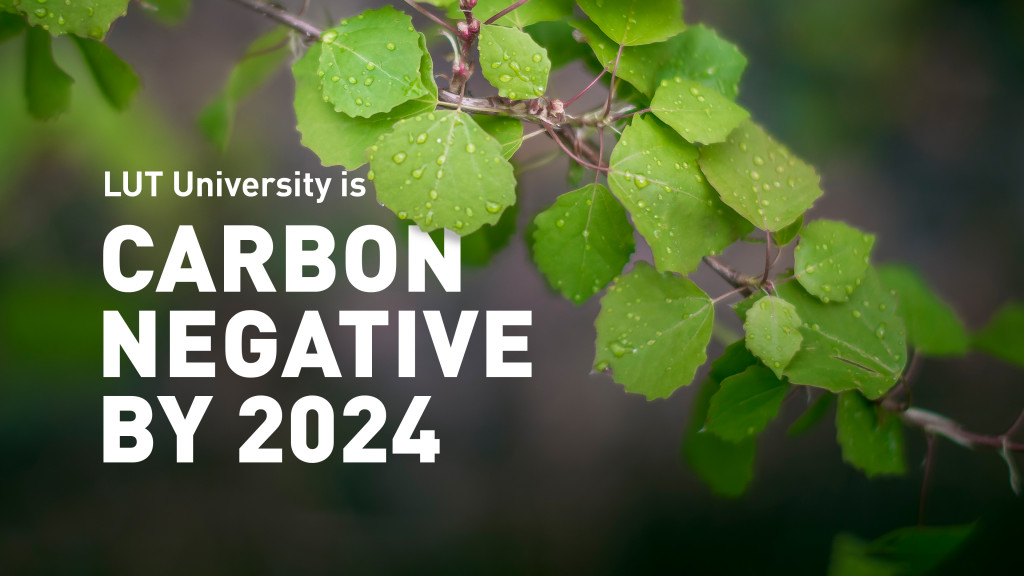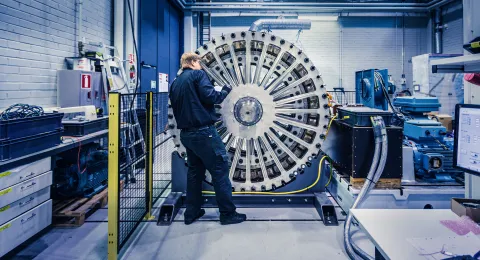LUT University will strive for carbon negativity by the end of 2024. It is an ambitious goal, the achievement of which is monitored by the Greenhouse Gas Protocol.
Professor Risto Soukka, Associate Professor Mika Luoranen and Sustainability Manager Kati Koikkalainen will answer these questions and explain LUT University's target for carbon negativity.
1. What is a carbon footprint?
LUT's carbon footprint refers to climate (carbon dioxide) emissions caused by the activities of the organisation and its people. The reported carbon footprint includes both direct and indirect emissions. For example, cars owned by LUT cause direct emissions, while emissions from bought electricity and staff commuting are considered indirect.
In 2020, LUT's carbon footprint was 1,593 tons of carbon dioxide equivalent (CO2eq). Mobility accounted for 51.4 per cent of the emissions, while food was the second largest cause for emissions with 18.6 per cent.
LUT calculates its carbon footprint using the Greenhouse Gas Protocol (GHG), which divides emissions into three dimensions or scopes. Scope 3, for example, includes district heating of a property. The calculations are used to analyse which emissions can be reduced and which needs to be compensated for.
The Impact Ranking of Times Higher Education also assesses LUT's work for sustainability and the climate based on the GHG protocol. THE is one of the world's most prestigious university rankings.
2. Who calculates LUT's carbon footprint?
LUT has its own Sustainability Science Carbon Negativity Team, which calculates the carbon footprint annually. The group comprises several experts from the university. The calculations are based on information collected from the university's units and stakeholders.

3. How is LUT's carbon footprint reduced?
The university follows the Climate Action Plan prepared with its staff and students. The programme is part of the management system. In addition, emission reductions are reported annually in sustainability reports.
The aim is to reduce electricity and heat consumption in buildings. The energy efficiency of the Lappeenranta campus has been greatly improved over the last 10 years, and LUT began operating on the energy-efficient Lahti campus in autumn 2019. Part of the campus electricity is produced by solar panels, and the purchased electricity is also produced with renewable energy. Furthermore, the campuses are heated with green district heating.
Another aim is to reduce the emissions from eating by encouraging the staff to eat vegetarian lunches. At the Lappeenranta campus, the canteens of Kampusravintolat Oy place the vegetarian food first on the line, and the carbon footprint of all options is visible.
4. How can LUT achieve carbon negativity?
LUT can achieve carbon negativity by monitoring, reducing and compensating for its emissions. During 2022, LUT will strive to create a consistent and even more accurate way to reduce emissions. It requires regular and automated collection of high-quality data, for example from suppliers.
The calculations show how LUT's carbon footprint is formed and which emissions can be tackled. However, carbon neutrality must be achieved before carbon negativity. Different calculations may be needed for different purposes: a total carbon footprint calculation of LUT University and a calculation that defines the need for compensation, based on which carbon negativity is achieved.
The goal is to achieve carbon negativity by the end of 2024. Along the way, the calculations are tested, specified and possibly expanded. For example, LUT's investment activities are not currently included in the calculations, whereas emissions from commuting are (GHG protocol scope 3). It is essential for the calculations to include issues that the university can influence and the reduction of which genuinely leads the development into the desired direction.
A negative carbon footprint means to offset more carbon than you contribute to the atmosphere. A partial solution is investing in carbon sinks. LUT University is unlikely to achieve carbon negativity just by reducing emissions – emission compensation is also needed. Nevertheless, LUT carries out goal-oriented and continuous work to reduce emissions as much as possible.
5. Why is achieving carbon negativity challenging?
Achieving carbon negativity is not simple. Collecting high-quality and sufficient information for calculation is challenging. Observing the carbon footprint, carbon neutrality and carbon negativity calculations simultaneously is also a challenge. In addition, emissions compensation costs are high.
A lot of research on energy-intensive industries is carried out at LUT with the aim of reducing greenhouse gas emissions significantly. Reducing emissions from research activities can be difficult in general, not to mention significant reductions. On the other hand, research is expected to help industries reduce emissions.
6. What is a handprint?
An environmental handprint refers to the positive climate and environmental impacts of different actions. At LUT University, the handprint is based on strategic and long-term scientific work carried out in order to achieve the preservation of natural resources, a more efficient material cycle, social sustainability, sustainable business and a cleaner environment and water.
LUT's handprint materializes above all in projects and theses carried out to reduce the carbon footprint of partners and stakeholders. In addition, hundreds of students graduating annually bring sustainability competence to society, which makes them a part of LUT's handprint.
7. Why is LUT striving for carbon negativity?
Clean energy, water and air are preconditions for life, and LUT University seeks solutions to them with expertise in technology and economics. Through its activities, LUT helps society and companies to renew sustainably, which is why the university has also set high targets for carbon negativity.
Carbon negativity is also sensible as it improves efficiency and reduces costs.
"LUT is actively striving to find solutions for combating climate change. LUT is among the top ten universities in the world for climate action. We will continue this work, and our aim is to maintain our position in the ranking", Risto Soukka sums up.

More information:






